TAG: GS 3: ENVIRONMENT
THE CONTEXT: The draft decisions taken at COP28 at Dubai have referred to the abatement and removal of carbon emissions using carbon capture and storage (CCS) and carbon-dioxide removal (CDR) technologies.
EXPLANATION:
- Considering the meaning of the word ‘abatement’ has become an important bone of contention, understanding the meaning and limitations of CCS is important – as also those of
- At COP28, the term “unabated fossil fuels” has come to mean the combustion of these fuels without using CCS technologies to capture their emissions. Draft decision texts point to a need to “phase out” such unabated fossil fuels. On the other hand, removal has been referenced in the context of the need to scale zero- and low-emission technologies and support forest restoration as a means to promote emission removal.
WHAT ARE CCS AND CDR?
- CCS refers to technologies that can capture carbon dioxide (CO₂) at a source of emissions before it is released into the atmosphere.
- These sources include the fossil fuel industry (where coal, oil and gas are combusted to generate power) and industrial processes like steel and cement production.
- CDR takes the forms of both natural means like afforestation or reforestation and technologies like direct air capture, where machines mimic trees by absorbing CO₂ from their surroundings and storing it underground.
- There are also more complex CDR technologies like enhanced rock weathering, where rocks are broken down chemically and the resulting rock particles can remove CO₂ from the atmosphere. Other technologies like bioenergy with carbon capture and storage (BECCS) capture and store CO₂ from burning biomass, like wood.
HOW WELL DO CCS AND CDR NEED TO WORK?
- While their technical details are clear, scientists have questions about the scale at which CCS and CDR are expected to succeed.
- The Sixth Assessment Report (AR6), prepared by the United Nations Intergovernmental Panel on Climate Change (IPCC), deals with climate mitigation. It relies a lot on the use of CDR for its projections related to the world achieving the goal of limiting the world’s average surface temperature increase to 1.5 degrees C with no or limited overshoot.
- The emission scenarios that the IPCC has assessed have more than a 50% chance of limiting warming to 1.5 degrees C assume the world can sequester 5 billion tonnes of CO₂ by 2040. This is more than India emits currently every year. There is no pathway to 1.5 degrees celsius in AR6 that doesn’t use CDR.
- If CO₂ emissions continue at current levels, we will have a 50% chance of exceeding 1.5 degrees C compared to pre-industrial levels in seven years .
- To achieve the decrease in CO₂ emissions by direct mitigation would be nearly impossible at this point and would require a lot of
HOW WELL DOES CDR WORK?
- CDR methods like afforestation, reforestation, BECCS, and direct air capture are constrained by their need for land.
- Land is often considered to be ‘viable’ for planting trees and deploying other large-scale CDR As a result, such CDR projects can adversely affect land rights of indigenous communities and biodiversity and compete with other forms of land-use, like agriculture that is crucial for ensuring food security.

WHAT ARE OTHER PITFALLS OF CCS AND CDR?
- By removing CO₂ from their environment, there are concerns that CCS and CDR create more ‘room’ to emit the greenhouse gas. In some cases, CCS has also been used to inject captured CO₂ is into oil fields to extract more oil.
- In future emissions scenarios that the IPCC has assessed, the world’s use of coal, oil, and gas in 2050 needs to decline by about 95%, 60%, and 45% respectively from their use in 2019 to keep the planet from warming by less than 1.5 degrees C. But without CCS, the expected reductions are 100%, 60%, and 70% for coal, oil, and gas by 2050.
- In a recent paper, an international group of researchers wrote that higher use of CCS and CDR make way for emissions pathways with a higher contribution from gas.
CONCLUSION:
There is need to identify viable and scalable CDR methods and need to figure out financial mechanism for CDR at a large scale in the future.
Spread the Word

Related posts
Why Takeoffs and Landings Are the Riskiest Flight Phases
Why retrieving black boxes matters in aviation accidents
The 14 questions President Murmu has asked the SC